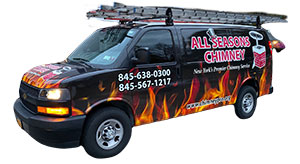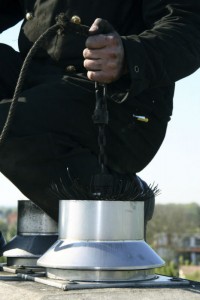A fireplace adds a certain ambiance that no other addition to the home does. The crackling warmth and the dancing flames – this mystical allure draws in people of all types and ages. Everyone loves a good fireplace, but when it starts causing frustrating problems, some homeowners would sooner forget it even exists! Before walling over your fireplace though, consider some basic troubleshooting ideas that may be behind the dysfunction.
Often, the most troubling problems have the simplest solutions. For example, the fire may extinguish quickly or send smoke into the house just because the damper has not opened correctly. Prior to lighting the fire, glance up the chimney with the damper open to make sure it has actually opened. When open, you should have a view of the entire flue. If all you see is darkness or mostly darkness, the damper has not opened properly. When jiggling the handle or turning it the opposite direction does not open the damper, call out a chimney expert to check the condition of it before lighting any more fires.
Another problem that may lead to a nonexistent, weak, or smoky fire is burning wet wood. This only applies to wood burning fireplaces, but it can be a serious problem. Firewood needs to season, or sit uncovered in a dry area, for one to two years prior to burning. Unseasoned wood usually has high water content, so most of the fire’s energy goes toward boiling the water away instead of making flames and heat. For this reason, wet wood often produces weak and smoky fires, if it even lights at all.
When these two issues have been solved or eliminated and the fireplace is still causing problems, there may be a draft problem in the house. Imagine hot air from the fire constantly moving up and out the chimney. This air comes from inside the house and it must be replaced in some way in order for the fire to continue burning properly. Sometimes the air cannot be replaced, which can be due to an overly airtight house – a common problem in newer construction. Fixing this might involve opening a window while burning or having an outside air vent installed.
A problematic draft can result from a variety of issues besides having an airtight home. For instance, an obstruction in the chimney could be blocking proper air flow. Possible obstructions include built up soot or creosote that needs to be cleaned or even an animal nesting inside the flue. The simple fix for this is to have the chimney swept at least once per year as required by fire codes. Another issue involves the structure of the chimney itself. The chimney may be too short or it may be too wide for a newer fireplace insert. Both of these situations can lead to weak and smoky fires. Have an annual chimney inspection along with a sweep to determine if this is the problem.
For more information on possible fireplace issues and to schedule a sweep and inspection in the Hudson Valley area, contact All Seasons Chimney.



 Experts from the National Fire Protection Association say chimneys must be swept at least once per year. For fireplaces and wood stoves that receive a lot of use, the association recommends more frequent sweeps. Chimney sweeps serve a couple vital functions to maintain the safety of the chimney and fireplace. The first role is to remove the creosote buildup inside the chimney. A product of burning wood, creosote is a black and tarry substance that rises through the chimney with the smoke and condenses on the interior surface as it cools. The residue builds on itself with every new fire and can even become so thick that it blocks the air flow through the chimney. A more ominous problem presented by creosote is its high flammability. A stray ember can ignite the creosote, resulting in a chimney fire. Because it burns many times hotter than wood or gas fires, the creosote fire can be difficult to extinguish, as well. Fortunately, chimney fires like this can be prevented by having a chimney sweep performed at least once every year.
Experts from the National Fire Protection Association say chimneys must be swept at least once per year. For fireplaces and wood stoves that receive a lot of use, the association recommends more frequent sweeps. Chimney sweeps serve a couple vital functions to maintain the safety of the chimney and fireplace. The first role is to remove the creosote buildup inside the chimney. A product of burning wood, creosote is a black and tarry substance that rises through the chimney with the smoke and condenses on the interior surface as it cools. The residue builds on itself with every new fire and can even become so thick that it blocks the air flow through the chimney. A more ominous problem presented by creosote is its high flammability. A stray ember can ignite the creosote, resulting in a chimney fire. Because it burns many times hotter than wood or gas fires, the creosote fire can be difficult to extinguish, as well. Fortunately, chimney fires like this can be prevented by having a chimney sweep performed at least once every year.